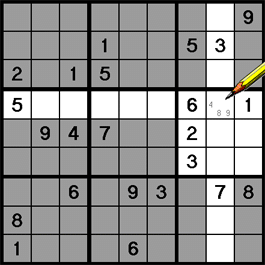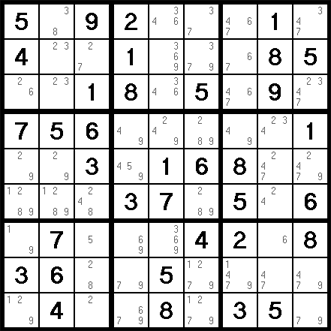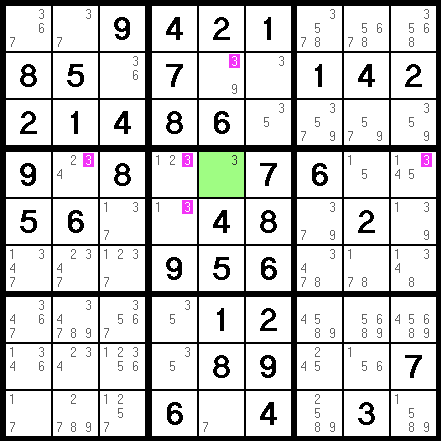Importance of Pencil Marks | Master Sudoku: From Beginner to Expert - Class 1 PDF Download
A note on Pencil Marks
Until now, the techniques I have covered do not require any "note taking". You have solved cells by simply scanning with your eyes.
But if you find yourself with a puzzle that is not yet complete, and you no longer see any "Open Singles" or numbers you can fill in using "Visual Elimination," then you will need to move on to Pencil Marks.
Although the act of making pencil marks itself is not a technique per se, it is something that is required for all of the rest of the Sudoku solving techniques.
In a nutshell, pencil marking is writing little numbers as a way of keeping track of the remaining possibilities, or candidates, for all the cells that are still unsolved. The idea is that you would then logically and methodically remove those marks, or candidates, one by one.
Here's how you do it:
Find an empty cell. Look at all the numbers in that cell's row, column, and block. Grab a pencil (so you can erase), and lightly write all the numbers that are still possible inside the cell. In other words, write all the numbers 1 through 9 except those that already appear in that same row, column, or block. These are all the cell's "candidates". Once you have filled in a cell, move on to the next, and repeat the process for all the empty cells.
 What you are basically doing is taking notes. You do not know what number actually goes in that cell, but you have it narrowed down to a list of candidates, and you are noting these candidates so you can see them at a glance.
What you are basically doing is taking notes. You do not know what number actually goes in that cell, but you have it narrowed down to a list of candidates, and you are noting these candidates so you can see them at a glance.
It is very important, though, that you write all the possible candidates in a cell before moving on. Don't go through first and do all the 1s, then the 2s, etc — because if you get distracted (if the phone rings or something), you may end up with some unfinished cells. Do one cell at a time, and finish that cell before moving on.
I recommend writing the "pencil marks" very lightly.
I also like to always put them in in the same uniform order: 1, 2, & 3 go across the top; 4, 5, & 6 across the middle, and 7, 8, & 9 along the bottom. Even if I am only writing 2 or three marks, I put them in their usual spots. This makes it easier to see identical pairs of them later.
Once you have all the pencil marks filled in, your puzzle will look something like this:

Note that a couple of the cells have only one pencil mark. Great! We want to see as many of these as possible. Why? Because when a cell gets down to only one candidate, that lone number must be the answer! But don't grab your pen just yet.
Lone Singles
A Lone Single is when a cell has only one pencil mark left. They are the result of all your hard work — filling in & erasing pencil marks. When you get a cell down to one candidate, you have solved that cell!
The popular computer program Sudoklue calls Lone Singles "Naked Singles".
All you need to do is pull out your eraser, erase that single pencil mark, and fill in the cell with your pen, right?
Well, yes — but there is another important step you must take. In most cases, filling in a cell will eliminate candidates in other pencil marked cells. So be very careful to look at all the other pencil marked cells in your cell's row, column, and block - and erase any corresponding pencil marks.
For example, in the sample below, you can see that the green cell must be a "3". Excellent! Get your pen and fill it in. But also notice the other cells that are affected. Suddenly, this new "3" makes all of the pink pencil impossible as candidates! You'll want to erase them.

You may notice that in erasing these pencil marks, you are creating at least one other lone single. Excellent! Move to that cell, rinse, and repeat…
Very often, when a puzzle gets down to the last 10 or so unsolved cells, a "chain reaction" of lone singles occurs, and the puzzle can be completed in seconds.
For the most part, the rest of the Sudoku solving techniques I will teach you do not actually solve a cell, but instead they remove pencil marks, using logic. This is called "candidate elimination". The goal is to get every unsolved cell down to one possibility (one pencil mark). When you have done this, you have solved the puzzle!
I think you'll find the logic we can use in the techniques to follow both challenging and satisfying. Remember, each cell only has one correct answer. Nothing feels better than to find those answers logically, using tried and true methods!
|
9 videos|76 docs
|
FAQs on Importance of Pencil Marks - Master Sudoku: From Beginner to Expert - Class 1
| 1. What are pencil marks in the context of Sudoku? |  |
| 2. How do lone singles work in Sudoku? |  |
| 3. Why are pencil marks important in solving Sudoku puzzles? |  |
| 4. How can I effectively use pencil marks to solve Sudoku puzzles faster? |  |
| 5. Can pencil marks lead to mistakes in Sudoku? |  |
















